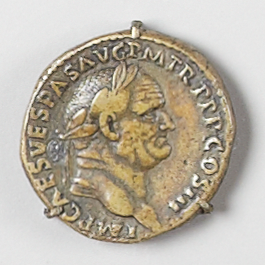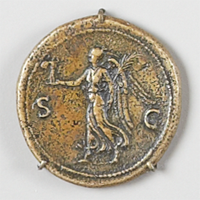Antico: The Golden Age of Renaissance Bronzes
May 1, 2012, through July 29, 2012
Ancient Roman Coins and Renaissance Collecting
Antico's first patron, Gianfrancesco Gonzaga, possessed more than two thousand Roman coins in his collection. Ancient coins inspired the Renaissance art form of the portrait medal, and, of all fifteenth-century examples, Antico's most closely resemble Roman coins, like the imperial sestertii below.
| |
 |
|
|
| |
Detail of Sestertius of Vespasian (3) |
|
|
Ancient Roman coins were highly prized by Renaissance collectors as historical records that preserved the faces, names, and deeds of great classical figures. The artistry of the portraits (3) and emblematic reverses (4) on ancient coins inspired deep admiration. In Antico's day it was believed that such exquisite
works were not used as currency but were purely commemorative,
like Renaissance medals.
Emperor Vespasian's portrait is inlaid with a tiny silver eagle (right). This Gonzaga emblem is a collector's mark that probably was inserted by a close descendant of Antico's patrons. The eagle, sacred to the god Jupiter, was a Roman imperial symbol like the Gonzaga thunderbolt — an emblem that appears on Antico's medal (8) and also on the Gonzaga Urn.
 |
|
3. Roman
Sestertius of Vespasian (69–79) (obverse shown)
Salus (reverse)
AD 71
Bronze with silver eagle inlay on obverse
Dr. Stephen K. and Janie Woo Scher Collection
|
 |
|
4. Roman
Sestertius of Galba (68–69)
(obverse)
Victory (reverse shown)
June–August AD 69
Bronze with silver eagle inlay on obverse
Dr. Stephen K. and Janie Woo Scher Collection
|
|


